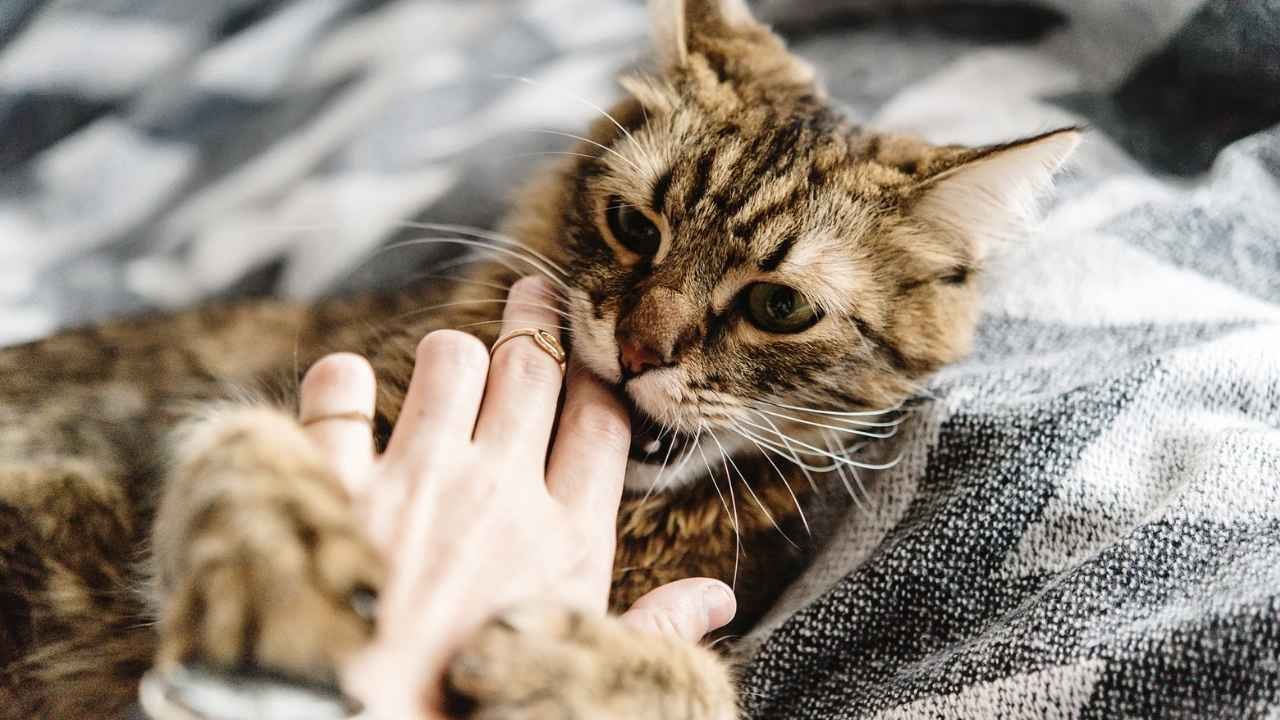Cats are playful creatures that often express their excitement through biting. While it’s a natural instinct, biting can become a problem if it’s excessive or aggressive. This behavior can be frustrating for cat owners and can potentially lead to injury.
This comprehensive guide will provide you with all the necessary knowledge and effective strategies to stop your cat from biting while playing. By understanding the underlying reasons behind biting, implementing proper training techniques, and providing appropriate alternatives, you can foster a harmonious and gentle play environment for both you and your feline companion.
Understanding Why Cats Bite
To effectively address biting behavior, it’s crucial to delve into the reasons why cats exhibit this action. Identifying the underlying causes will help you tailor your approach to suit your cat’s specific needs.
Overstimulation: Cats can become overexcited or overwhelmed during play sessions, leading to biting as a way to communicate their distress or discomfort. Certain actions, such as rough petting or using toys that are too aggressive, can trigger this overstimulation.
Excitement: Biting can be a natural form of expression for cats, especially when they’re feeling playful or excited. It’s essential to recognize the difference between gentle love bites and aggressive biting.
Lack of appropriate outlets: If cats do not have sufficient opportunities to release their pent-up energy through play and exercise, they may resort to biting as an outlet for their frustration.
Learned behavior: Cats can learn to bite if they receive attention or treats as a reward for this behavior. This reinforces the idea that biting is an acceptable way to interact with humans.
Effective Training Techniques
Redirection and Rewards: When your cat bites during play, immediately redirect their attention to an appropriate toy or activity. Praise and reward them with treats or petting when they engage in gentle play. This technique helps your cat associate biting with negative consequences and rewards them for desired behaviors.
Time-Outs: If biting persists, implement a brief time-out. Remove your cat from the play session and place them in a quiet space for a few minutes. This communicates that biting is unacceptable and provides them with an opportunity to calm down.
Consistency and Patience: Training takes time and consistency. Be patient with your cat and remain consistent in your approach. Avoid punishing your cat for biting, as this can damage your bond and make them fearful.
Step by Step: Start training sessions in short intervals and gradually increase the duration as your cat makes progress. This allows your cat to adjust and learn at their own pace.
Identify Triggers: Observe your cat’s behavior to identify any specific actions or situations that trigger biting. Once you pinpoint these triggers, you can modify your play style or environment to avoid them.
Providing Appropriate Alternatives
In addition to implementing training techniques, it’s essential to provide your cat with appropriate alternatives to biting. This will give them healthy outlets to release their energy and redirect their playful behavior.
Interactive Toys: Engage your cat in interactive play sessions using toys that encourage chasing, pouncing, and batting. Feather wands, laser pointers, and puzzle toys stimulate their natural hunting instincts and provide a safe and satisfying outlet for their energy.
Physical Exercise: Ensure your cat has ample opportunities for physical exercise. Provide climbing structures, scratching posts, and designated play areas. Regular exercise helps reduce pent-up energy and fosters a positive and balanced emotional state.
Calming Aids: If your cat exhibits signs of overstimulation or anxiety, consider using calming aids such as pheromone diffusers or calming treats. These aids can help reduce stress and promote a more relaxed environment for your cat.
Additional Tips
Observe Your Cat’s Body Language: Pay attention to your cat’s body language to gauge their level of arousal and excitement. Signs of overstimulation include dilated pupils, flattened ears, and a twitching tail.
Avoid Rough Play: Refrain from engaging in rough or aggressive play that may encourage biting behavior. Instead, opt for gentle and interactive activities that promote bonding and cooperation.
Respect Your Cat’s Boundaries: Respect your cat’s personal space and avoid petting or handling them when they’re not receptive. This helps prevent biting out of fear or discomfort.
Seek Professional Help: If biting persists despite implementing these techniques, consider seeking professional guidance from a veterinarian or certified animal behaviorist. They can evaluate your cat’s specific needs and develop a tailored training plan.
Conclusion
By understanding the underlying causes of biting, implementing effective training techniques, and providing appropriate alternatives, you can effectively stop your cat from biting while playing. Remember to approach training with patience, consistency, and positive reinforcement. By fostering a harmonious and gentle play environment, you can strengthen your bond with your feline companion and enjoy their playful nature without the worry of biting.
| Safe Human Foods for Cats |
| How to Tell if Your Cat Has a Fever |
| What Does it Mean When a Cat Purrs Loudly? |
Frequently Asked Questions
1. Why is my cat biting me while playing?
Answer: Cats may bite during play to mimic hunting behavior, express excitement, or relieve stress.
2. How can I prevent my cat from biting in the first place?
Answer: Establish clear boundaries, avoid rough play, and redirect aggression to appropriate toys.
3. What should I do if my cat bites me?
Answer: Stop playing immediately, say “no” firmly, and leave the room for a short time.
4. How can I redirect my cat’s biting?
Answer: Offer a safe outlet for aggression, such as a catnip toy, scratching post, or chasing wand.
5. What should I avoid doing when my cat bites?
Answer: Avoid punishing or scolding, as this can make the problem worse.
6. How long will it take to stop my cat from biting?
Answer: The time frame varies depending on the cat’s personality and the consistency of your training.
7. Should I use a spray bottle?
Answer: Using a spray bottle can be effective for redirecting biting, but must be used consistently and humanely.
8. What if my cat is a kitten?
Answer: Kittens may bite more frequently, but the training techniques mentioned apply to them as well.
9. How can I tell if my cat is playing or being aggressive?
Answer: Signs of play include relaxed body language, playful paws, and tail flicks. Signs of aggression include stiff body, arched back, and hissing.
10. I’ve tried everything and my cat still bites. What should I do?
Answer: If home remedies are not effective, consult with a veterinarian or animal behaviorist for additional guidance.




